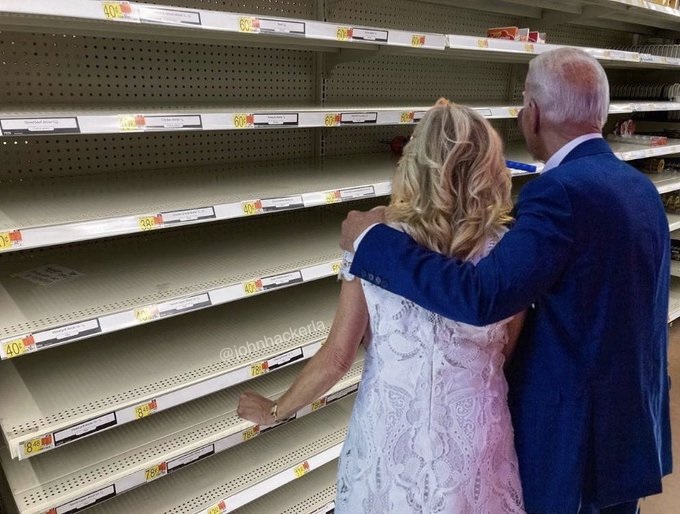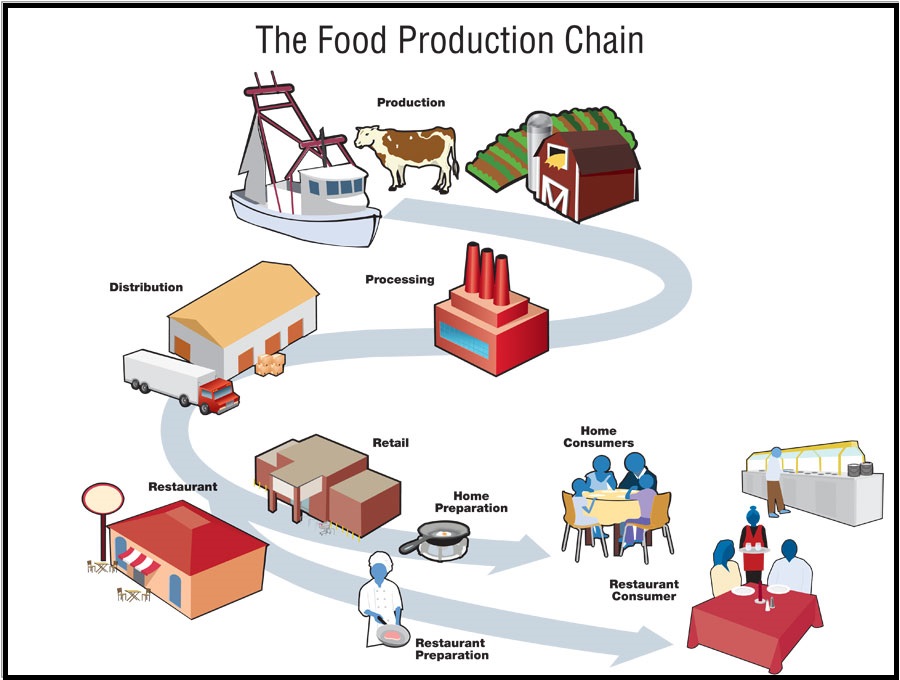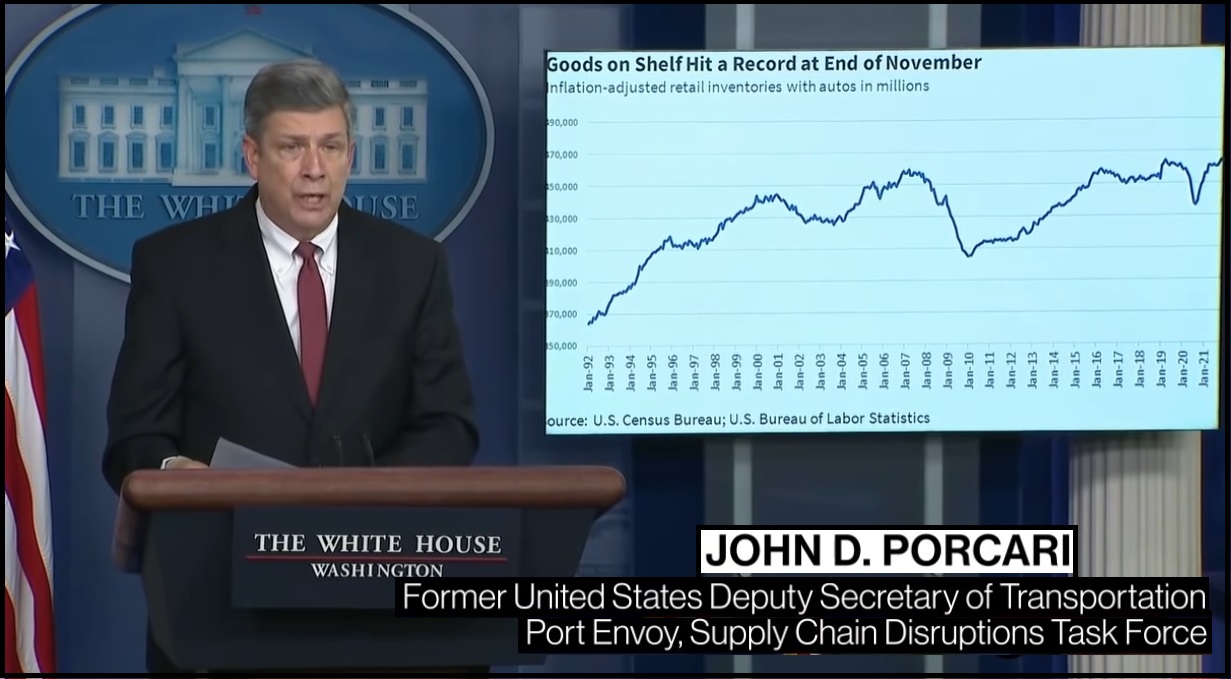
The U.S. government does not operate in a vacuum without knowledge of what is happening and a solid perspective on what is likely to happen. Whether they listen to the commonsense advisors, or whether the control officers intentionally keep counter positions away from the principle, is another matter; however, the officials generally know what is most likely to happen.
The White House put Port Envoy John D. Porcari, who is also intricately involved in the supply chain taskforce, on the podium today to discuss supply chain issues. The full video of his remarks is posted below, but my spidey sense is telling me they know what we know, and they are starting to prepare for what will ultimately become impossible to ignore. WATCH:
It’s not just a port issue, as we have discussed on these pages, the interventionist policies and regulations from the people creating the COVID response (writ large) have been fubar from the beginning. {Go Deep} When they shut down the restaurants and hospitality sector (2020 lockdowns), the advisors and bureaucrats triggered a cascading series of events inside the food supply chain.
 I know it sounds weird to try and wrap your arms around, but those early decisions in 2020 created a problem that only a very few people could see and follow to its natural conclusion.
I know it sounds weird to try and wrap your arms around, but those early decisions in 2020 created a problem that only a very few people could see and follow to its natural conclusion.
The 60/40 supply chain for food away from home (restaurants, fast-food locales, schools, cafeterias etc.), and food at home (supermarkets and grocery stores etc.), is not something you can just fiddle around with. {Go Deep}
Supply chains are challenging on their own. However, within the various supply chains, the supply chain for U.S. food distribution is the most complex supply chain in the world. There’s nothing even close. It was created by decades of free market operators following efficiencies of scale to produce the best, most wholesome and reliable food supply chain ever created. In many ways it is our best national security advantage.
The free-market distribution system would eventually overcome the problem and reestablish its efficiencies. However, given the scale of disruption -and the fact that catch up harvests are seasonal- it was obviously taking several years.
Most Americans were not aware going into the COVID mitigation effort that food consumption in the U.S. was a 60/40 proposition. Approximately 60% of all food was consumed “outside the home” (or food away from home), and 40% of all food consumed was food “inside the home” (grocery shoppers).
Food ‘outside the home’ includes restaurants, fast food locales, schools, corporate cafeterias, university lunchrooms, manufacturing cafeterias, hotels, food trucks, park and amusement food sellers and many more. Many of those venues are not thought about when people evaluate the overall U.S. food delivery system; however, this network was approximately 60 percent of all food consumption on a daily basis.
The ‘food away from home‘ sector has its own supply chain. Very few restaurants and venues (cited above) purchase food products from retail grocery outlets. As a result of the coronavirus mitigation effort, the ‘food away from home’ sector was reduced by 75% of daily food delivery operations. However, people still needed to eat. That meant retail food outlets, grocers, would see sales increases of 25 to 50 percent, depending on the area.
The retail consumer supply chain for manufactured and processed food products includes bulk storage to compensate for seasonality. As Agriculture Secretary Sonny Perdue noted in 2020, “There are over 800 commercial and public warehouses in the continental 48 states that store frozen products.”
Here is a snapshot of the food we had in storage at the end of February 2020: over 302 million pounds of frozen butter; 1.36 billion pounds of frozen cheese; 925 million pounds of frozen chicken; over 1 billion pounds of frozen fruit; nearly 2.04 billion pounds of frozen vegetables; 491 million pounds of frozen beef; and nearly 662 million pounds of frozen pork.
This bulk food storage is how the total U.S. consumer food supply ensures consistent availability even with weather impacts. As a nation, we essentially stay one harvest ahead of demand by storing it and smoothing out any peak/valley shortfalls. There are a total of 175,642 commercial facilities involved in this supply chain across the country
The stored food supply is the originating resource for food manufacturers who process the ingredients into a variety of branded food products and distribute to your local supermarket. That bulk stored food, and the subsequent supply chain, is entirely separate from the fresh food supply chain used by restaurants, hotels, cafeterias etc.
For almost four months in 2020, the retail supply chain was operating way beyond capacity, as most “food away from home” was turned off or severely limited. The burn rate of raw food products in storage jumped a stunning 40 percent. Those bulk warehouses, the feeder pools for retail/consumer manufactured food products, started to run low as the various states kept making rules about restaurant capacity and venue availability due to COVID.
Believe me, we don’t want to find out what happens when those 800 mass storage facilities run out. This “bigger picture” was not being considered by politically minded governors, DC politicians, and public health-centric advisors who focused exclusively on using the politics of the virus for control.
Here we are, two years later, and the currently empty shelves, in combination with layers of new short-sighted policy, are a downstream consequence of that originating disruption.
The best thing government could do to avoid a crisis would have been to do nothing. Just let people go back to normal, and that would have allowed the market process to eventually correct itself. However, they didn’t stop -and worse- the Biden administration started implementing massive policy changes (energy policy, regulatory policy, legislative policy, monetary policy) while simultaneously pumping COVID bailout money into the economy.
As the food sector tried to gain its footing, the wave of price increases driven by energy policy only made things worse. We have been seeing these staggering price increases at the grocery store. Then, at the worst possible time, the new Omicron narrative “a winter of death awaits” was pushed. Now, the labor side of the supply chain equation is hit even harder stressing out every facet of the food distribution system.
Instead of just preparing for massive price increases, we are now preparing for massive shortages in this most important sector.
People are starting to see completely blown-out empty shelves and slow replenishment. Soon, as a result of this situation worsening, there is very likely to be public pressure on government to solve the problem which, ironically and insufferably, the government intervention created.
How will the White House respond to demands that someone fix the problem of empty shelves?
You already know the answer to that question, and it isn’t good.
Here’s the full presser with John D. Porcari (prompted):


